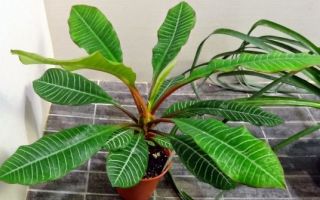Content
- 1 Description and features of milkweed
- 2 Types of indoor milkweed
- 3 The chemical composition of milkweed
- 4 What is euphorbia useful and what does it heal
- 5 Milkweed-based traditional medicine recipes
- 6 Useful properties of milkweed honey
- 7 Why is the spurge dangerous?
- 8 First aid for poisoning
- 9 Signs and superstitions associated with milkweed
- 10 Where is it better not to put spurge
- 11 Milkweed Care Precautions
- 12 Conclusion
- 13 Reviews
Among all the variety of medicinal plants, euphorbia is considered one of the most effective and at the same time the most poisonous. The benefits and harms of milkweed equally arouse interest and fear among everyone who has ever come across it, and therefore it will not be superfluous to understand its properties.
Description and features of milkweed
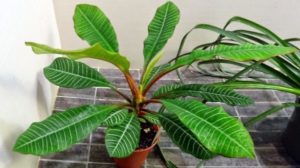
The plant belongs to the Euphorbia family, in which there are over 1500 species. On the territory of Russia alone, there are about 150 varieties of milkweed. In appearance, they are very different from each other and may look like small trees, annual grasses or perennial cactus-like shrubs, but they all have one common property, namely, the presence of caustic sap of white color, similar to milk. This genus of plants owes its name to him.
Answering the question of whether the spurge is poisonous or not, yes, many of its varieties are very toxic, but this does not in the least spoil their reputation as beautiful and undemanding indoor flowers. In addition, the beneficial properties of the plant are widely known. All parts of this plant are used in pharmacology and folk medicine, including the root and flowers.
Types of indoor milkweed
The variety of milkweed species, as well as unpretentious care, have made them popular among gardeners around the world. Euphorbia is resistant to various temperature conditions and does not require abundant watering, and the spectacular appearance of this indoor plant becomes an additional argument in favor of decorating the interior of an apartment with it.
The table below shows the most popular varieties of indoor milkweed.
|
Name |
Features: |
Toxicity |
|
|
Belozhilkovy |
Euphorbia leuconeura |
Fleshy bright green leafy plates with white veins on the obverse. |
Yes |
|
Ribbed (comb) |
Euphorbia lophogona |
On the outside of the leaf there are light green streaks. The stem is covered with spinous processes. |
|
|
Mile |
Euphorbia milii |
It has a gray, bumpy stem and small red, orange, crimson and yellow flowers. |
Yes |
|
Triangular (triangular) |
Euphorbia trigona |
There are many brown thorns and small spatulate leaves on the vertical shoots. |
Yes |
|
The most beautiful (poinsettia) |
Euphorbia pulcherrima |
Has bright red bracts that look like leaves. Blooms in December. |
Yes |
|
"Head of Medusa" |
Euphorbia caput-medusae |
Horizontal gray-green bumpy shoots, similar to woven snakes. |
Yes |
|
Fat |
Euphorbia obesa |
The spherical shape resembles a cactus. |
Yes |
The chemical composition of milkweed
Although the benefits of milkweed have been known for a long time, the chemical properties of this group of plants have not yet been thoroughly studied due to the large variety of its representatives. Nevertheless, studies have shown that the main constituent of the milky sap of the plant is euphorbon. It also contains mineral salts and amphora gum.The roots of the plant contain ascorbic acid, tannins, glycosides, resins and alkaloid compounds.
What is euphorbia useful and what does it heal
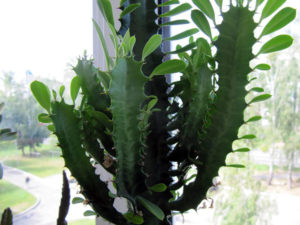
The beneficial properties of milkweed have been used since ancient times as a medicine in many countries of the world, in particular, on the African continent. It is actively used in both traditional and alternative medicine in the treatment of a wide range of diseases. Euphorbia has proven to be beneficial for people suffering from peptic ulcers and disorders of the gastrointestinal tract. It is also an effective remedy for constipation.
The sap of the plant has a diuretic and anthelmintic properties, in connection with which formulations based on it have a deep cleansing effect on the body and remove harmful toxins and toxins. In addition, milkweed juice helps to reduce edema and accelerate the healing of abrasions and burns. It effectively removes warts and other skin damage.
The antibacterial properties of the beneficial resins and tannins of milkweed are often used to prevent diseases of the upper respiratory tract. Flavonoids in the plant successfully regulate liver function, eliminating harmful breakdown products of nutrients. A large amount of selenium has a beneficial effect on the elasticity of blood vessels and normalizes the work of the musculoskeletal system.
Euphorbia brings considerable benefits to the body of men. It can be used to treat inflammation of the genitourinary system and erectile dysfunction. In addition, it is able to enhance libido and increase male potency.
Milkweed-based traditional medicine recipes
Euphorbia has long established itself as a medicine, and since it is found in almost every flower lover's house, they often try to benefit from this and make a healing composition based on it at home.
Milkweed juice
Milkweed juice is perhaps the most valuable component of this plant. The drug euphorbium is made from it, which is used in the treatment of a number of ailments, and is also used as an emetic and laxative. Despite its toxicity, it was used to treat warts, calluses, lichen, eczema and other skin diseases with its help. The whitening properties of the juice have been used to remove freckles.
Decoctions of milkweed leaves and stems
The benefits of milkweed decoctions are in the calming effect they have on the nervous system. However, so that the broth does not harm your health, you need to be able to cook it correctly. This requires.
- 5 g of leaves and stems pour 0.5 liters of water.
- Boil for 10 minutes over medium heat.
- Consume 1 tbsp. l. twice a day before meals.
Milkweed leaves and stems tea
In case of kidney diseases, cystitis and hemorrhoids, the benefits of tea made from milkweed leaves and stems are noted. Its healing properties are used in the complex treatment of anemia and impotence. To prepare tea you should:
- Boil plant materials for 20 minutes to get rid of harmful plant compounds.
- Thoroughly squeeze the raw material and then dry.
- Grind the plant parts into powder.
- Dissolve the mixture in water or tea.
- Take 1 tbsp. l. a day after meals.
Milkweed root tincture
Since spurge has anti-inflammatory properties and suppresses the development of tumors, tincture from its root is often used as an adjuvant in cancer of the gastrointestinal tract and uterine myoma. To make an alcoholic tincture at home, you need:
- 10 g of chopped plant roots pour 500 ml of vodka.
- Leave the composition in a cool dark place and let it brew for 10 - 14 days.
- Take the tincture for a month, 15 drops 3 times a day, gradually increasing the dose to 30 drops. Then, over the course of a month, gradually reduce the dosage to the initial 15 drops.
With especially complex forms of diseases, the course of taking the tincture can be increased to 3 - 5 months. To avoid harm to health, it is important not to exceed the recommended dosage.
Milk Seed Oil
Many people know about the beneficial properties of castor oil. However, few people know that it is extracted from the seeds of a plant of the Euphorbiaceae family, which is called castor oil plant. Castor oil has long been proven to help heal cuts, wounds, and boils. It is used in inhalation for bronchitis, tuberculosis and other lung diseases. But cosmetics manufacturers derive the greatest benefit from such oil, since its properties help accelerate the growth of hair and nails, give them strength and heal the scalp. For these reasons, milk oil is added to shampoos, creams, soaps, masks and other beauty products. It also serves as a component in many home beauty recipes.
- Anti-wrinkle mask... To eliminate wrinkles, mix equal parts of castor, olive and peach oils. Warm up the mixture in a water bath and lubricate the skin in the area of wrinkles. After 15 minutes, wash off with water at room temperature. The procedure is repeated twice a day.
- Mask for dry skin... A mixture of castor and peach oils is combined in a 1 to 2 ratio and the composition is used as a cream daily.
- To soften calluses... The oil is applied to the feet all night and socks are put on. The procedure is repeated three times a week.
Useful properties of milkweed honey
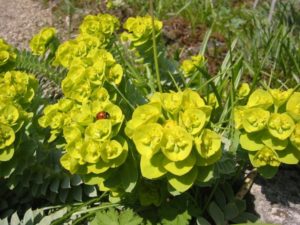
The benefits of milkweed flowers are manifested in their melliferous properties. The fresh honey of this plant is a brown mass resembling syrup in consistency. Over time, it hardens and takes on a dense, dense texture. Such honey owes its dark shade to its high iodine content, which makes it especially useful if a person has problems with the thyroid gland. In addition, the benefit of milkweed honey is that it increases the body's defenses and helps fight infections and harmful microorganisms. The beneficial properties of milkweed honey also apply to people with diseases of the cardiovascular system, chronic fatigue, and insomnia.
Why is the spurge dangerous?
Although spurge is a unique houseplant and has significant benefits, it can cause serious harm to humans, as many of its parts are toxic. In this regard, milkweed-based preparations are prohibited from taking the following groups of persons:
- children;
- pregnant women;
- nursing mothers;
- allergy sufferers;
- suffering from plant intolerance;
- having diseases of the cardiovascular system.
Healthy people should also be careful in handling milkweed. If the milkweed-based formulations are misused or the conditions for its maintenance in the apartment are violated, all the benefits of the plant can result in harm to the body. So, this plant can provoke chemical burns or serious poisoning.
Skin burn
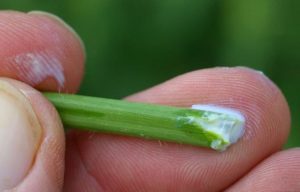
Being a very poisonous plant, euphorbia, in particular, its juice, aggressively affects the skin, causing a chemical burn, which is accompanied by severe pain and profuse rashes.
When the milky sap of the plant comes into contact with the skin, it is required to immediately rinse the affected area of the skin with plenty of clean water, and then cover the burned area with ice to reduce pain.
Milkweed juice in the eyes
A very serious harm to health can be caused by the milky sap of the plant, in particular, the milkweed, if it gets into the eyes.If this happens, you need to immediately rinse the affected eye with running water or a decoction of chamomile in order to completely wash off the toxic milkweed liquid, and then urgently seek medical attention. To speed up the diagnostic and treatment procedure, it is advisable to show the doctor a sample of the plant that caused the burn.
The severity of eye damage varies depending on the type of milkweed. Burns of this kind are characterized by the following symptoms:
- burning sensation;
- pain;
- photophobia;
- lacrimation;
- swelling of the eyelids;
- deterioration of vision.
Poisoning with milkweed juice
Poisoning with milkweed juice occurs when poisonous plant fluids enter the body. An increased risk of intoxication occurs in the following situations:
- Weeding... Many plants of the Euphorbiaceae family are classified as weeds, due to their property to thrive on almost any soil.
- Home flower care... Most of the types of indoor milkweed so beloved by flower growers have poisonous properties.
- Making medicinal compositions based on a plant at home. Exceeding the dosage when using decoctions and tinctures, for example, based on white milkweed, can, instead of benefit, cause extensive harm to the entire body.
- Plants games... Often, poisoning occurs precisely in children if a toxic flower is in the child's reach.
When a person takes concentrated milkweed juice or eats plant materials for 6 to 12 hours, signs of poisoning appear, including:
- dizziness;
- headache;
- nausea;
- burning sensation in the throat;
- sharp pain in the abdomen;
- vomiting;
- diarrhea;
- dehydration of the body.
As soon as the poisonous substances of the plant are completely absorbed into the blood, the victim's body temperature rises, consciousness is confused, convulsions and disorientation are observed. Without timely action, a coma is likely.
First aid for poisoning
If milkweed juice still gets into the body, you need to immediately call an ambulance! Before the arrival of doctors, you should:
- Put the victim on the bed and try to organize him physical rest.
- Ensure the body is cleansed of harmful compounds by offering the patient 100 g of activated carbon 80 - 100 g or a saline laxative.
- Give the patient some alkaline mineral water, milk or jelly to reduce the harm from toxic substances to the stomach.
Signs and superstitions associated with milkweed
In addition to healing, milkweed is also credited with magical properties. So, the followers of the Feng Shui movement do not recommend putting the thorny representatives of this family of plants in the bedroom, so as not to provoke discord and quarrels in the relationship of spouses or lovers. A better place would be a computer desk, where the spurge will take on negative energy associated with work and financial affairs.
In addition, there is a belief that the plant attracts good luck in the professional sphere and promotes career advancement. It also has the property of "luring" money and protects its owner from the harmful effects of evil forces and evil eyes.
Where is it better not to put spurge
Euphorbia is a rather unpretentious plant, the care of which does not cause much trouble even for novice growers. Despite its tropical origin, it tolerates the conditions of the temperate climatic zone quite well. This plant thrives in rooms with good lighting without drafts at a temperature of 18 - 20 ° C.
However, when choosing a place for a pot of milkweed, lovers of this plant should take into account its toxic properties. In many species of milkweed, not only the juice, but also the leaves and stems, has a harmful effect, therefore it is very important that the plant is never in places accessible to children.
If there are animals in the house, it is also worth limiting their access to the room where the euphorbia is, since pets, especially cats, have a habit of chewing on green spaces and can harm themselves and even die.
If you cannot drive the animal away from the flower pot, you may need to refuse to buy such a plant in order to avoid possible harm.
Milkweed Care Precautions
It is quite easy to take care of indoor milkweed, since it does not require much attention to itself. Nevertheless, it is worth observing certain safety measures in order to protect yourself from the harmful effects of the plant.
- Pruning, replanting and other gardening work should be done with thick protective gloves. They must certainly be rubber, since through the tissue harmful plant toxins can get onto the skin.
- Even when wearing gloves, you need to wash your hands thoroughly with soap and water at every contact with the plant.
- Additional protective equipment such as goggles and mouth mask should not be neglected. Even with the seemingly safest procedure, there is a possibility of damaging the plant, after which milkweed juice from gloves can get onto the mucous membranes of the eyes or mouth.
- One must also remember to wash the tools immediately after pruning and transplanting the plant.
- It is important to keep children and animals away from the milkweed.
Conclusion
The benefits and harms of milkweed are of interest to many people due to the widespread prevalence of this plant family. Its useful properties were appreciated not only in folk, but also in traditional medicine, and its beauty and undemandingness made it one of the most beloved green decorations in the house. With proper care and compliance with safety rules, the potential harm to milkweed will be minimized: the flower will delight its owners for a long time.

